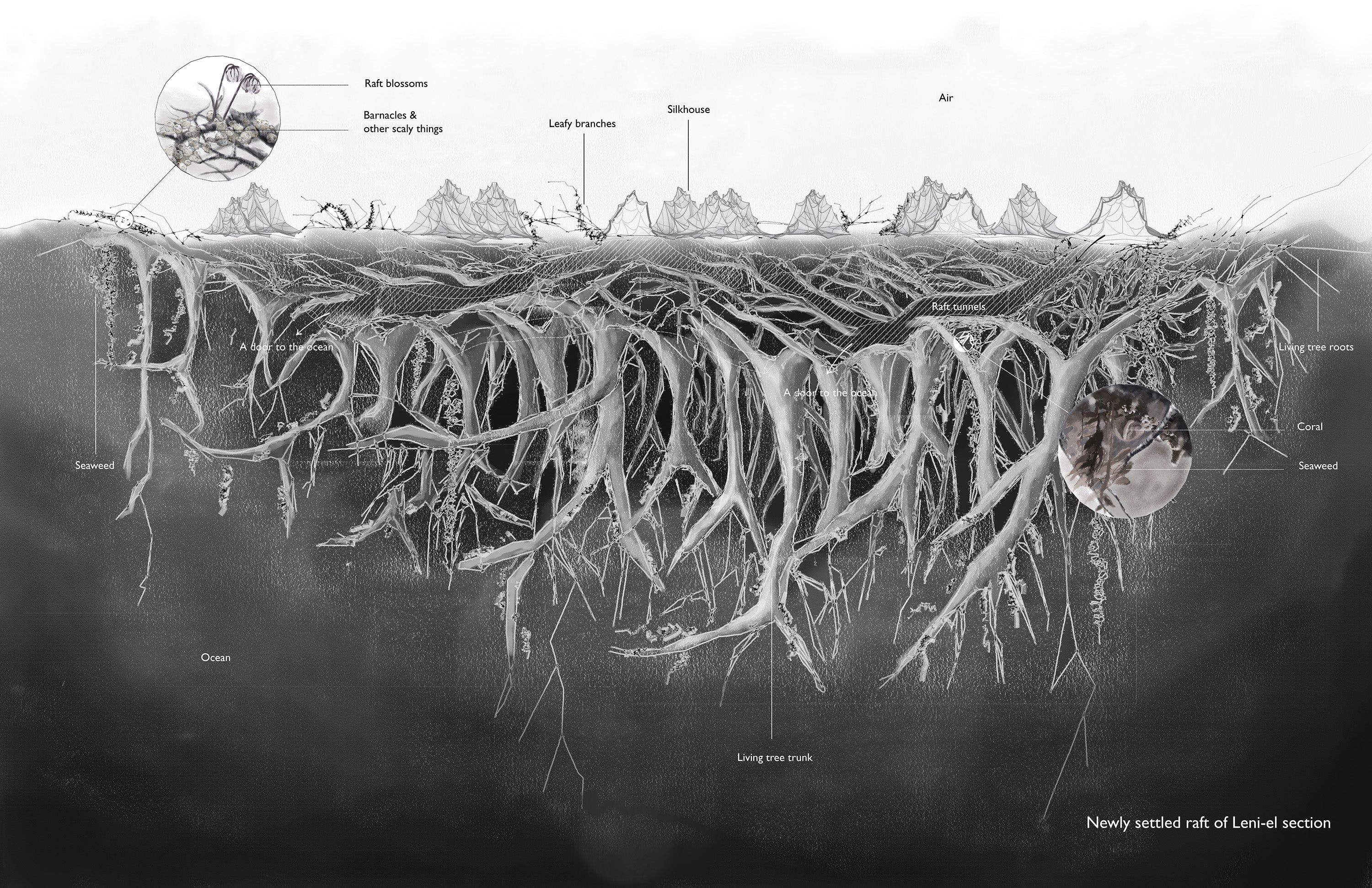
Of the thesis entitled: A Journey to Shora: Expressing the Architectural Environment Behind A Door into Ocean
Abstract:
This
thesis
seeks
to
express
the
architectural
environment
behind
Joan
Slonczewski’s
1986
science-fiction
novel,
A
Door
into
Ocean.
The
novel
describes
a
water-covered
planet
called
Shora,
its
inhabitants,
Sharers,
and
their
alternative
way
of
life
on
living
rafts.
Building
on
Slonczewski’s
writing,
I
present
a
series
of
digital
paintings
and
a
narrative
to
express
what
living
on
Shora’s
rafts
might
feel
like
for
its
residents.
Using
case-studies
of
existing
projects
and
research
in
the
world
of
living
architecture
and
bio-design,
I
situate
this
project
within
contemporary
architecture,
attempting
to
envision
how
it
might
feel
to
occupy
a
world
of
living
things.
Life
is
characterized
by
the
ability
to
evolve,
metabolize,
and
reproduce.
Throughout
history,
human
attempts
to
provide
a
safe
living
environment
have
led
us
to
a
separation
between
the
built
environment
and
nature.
With
today’s
environmental
concerns,
it
is
imperative
for
us
to
consider
visionary
approaches
to
architecture
that
imagine
a
living
architecture
instead
of
a
non-living
one.
Inspiration
from
and
use
of
the
living
world
in
design
is
encompassed
in
a
large
body
of
work
by
designers
and
researchers.
Biomimicry
(mimicking
features
or
behaviours
of
living
things),
bio-design
(synthesizing
new
hybrid
typologies
by
using
living
organisms
as
the
main
elements
of
the
built
environment),
living
and
soft-living
architecture
(using
living
organisms
or
lively
matters
in
design),
and
ecological
design
(minimizing
design’s
environmentally
destructive
impacts
through
integration
with
living
processes)
overlap
and
inform
the
efforts
of
many
working
in
the
field.
These
attempts
at
living
architecture,
however,
remain
mostly
at
a
small
scale
in
laboratories
or
at
the
scale
of
installations
or
concept
designs.
As
the
field
grows,
it
is
important
to
envision
how
the
techniques
being
developed
in
smaller
scales
can
affect
a
new
way
of
life
in
the
future.
I
am
particularly
interesting
in
representing
how
architecture
might
go
beyond
biomimicry,
and
use
living
organisms
as
the
main
elements
of
the
built
environment
as
described
in
Shora.
A
Door
into
Ocean
is
a
compelling
critique
of
human
life,
achieved
through
“rejecting
the
terrestrial” and
refusing
totalitarianism
and
dictatorship,
all
seen
in
Sharers’
harmonized
living
with
their
aquatic
environment.
Acting
as
a
robust
ecosystem
for
many
different
marine
species
without
threatening
their
lives,
Shora
might
represent
the
future
bio-designers
dream
about.
The
Sharers
use
genetic
engineering
to
enable
the
co-existence
of
different
living
materials
and
their
hastened
evolution
as
needed.
They
use
scaffolding
and
weaving
technique
to
create
semi-permanent
structures
covered
with
living
organisms.
Finally,
they
modify
their
own
bodies
to
further
adapt
to
their
environment.
Through
all
these
techniques,
the
world
in
A
Door
into
Ocean
combines
bio-design
and
living
architecture
to
arrive
at
a
balanced
ecological
approach
to
life
with
the
natural
world.
Shora is a work of science-fiction, set on a fictional planet. Arriving at Shora’s architecture today is similarly next-to-impossible, requiring systematic changes not just to our architectural systems, but also to our socio-political ways of life. Shora can, however, act as a window to a possible alternative vision. In this way, my role as the architect is to express this world through drawings and narratives. Through this exercise of expressing the imagined, we might get closer to answering larger questions about living architecture: What is the quality of an architecture merged with nature? What are the characteristics of this kind of architecture? How does it feel like to live in such a world?
The examining committee is as follows:
Supervisor:
Philip Beesley, University of Waterloo
Committee Member:
Dereck
Revington,
University
of
Waterloo
Jane
Hutton,
University
of
Waterloo
External Reader:
Trevor Haldenby, Syntegrity
The
committee
has
been
approved
as
authorized
by
the
Graduate
Studies
Committee.
The
Defence
Examination
will
take
place:
Friday
May
3,
2019
10:00
AM
Loft
A
copy
of
the
thesis
is
available
for
perusal
in
ARC
2106A.